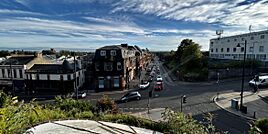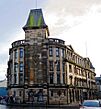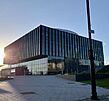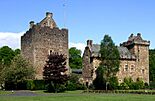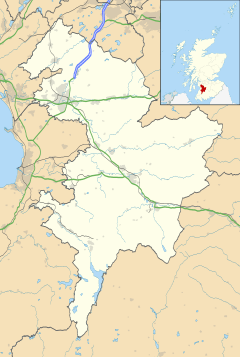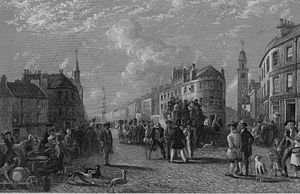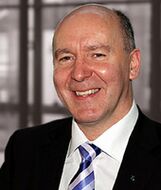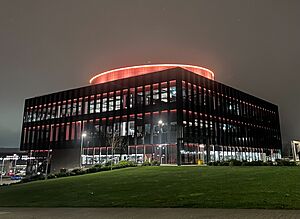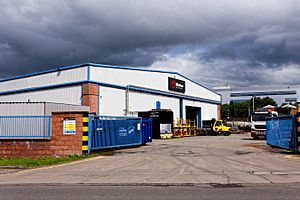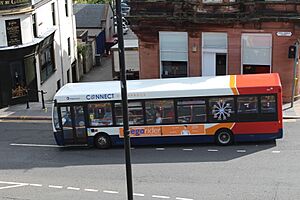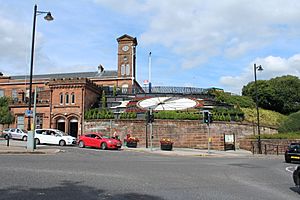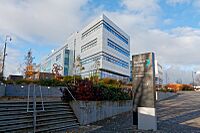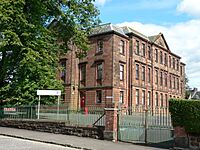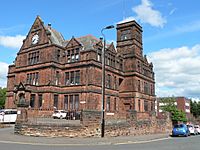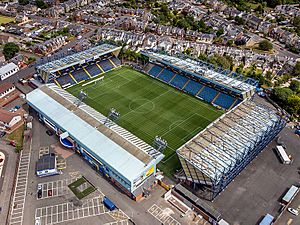Kilmarnock facts for kids
Quick facts for kids Kilmarnock
|
|
|---|---|
| Administrative centre, town and former burgh | |
|
Coat of Arms of the Burgh of Kilmarnock |
|
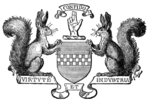 Coat of Arms |
|
| Area | 27.3 km2 (10.5 sq mi) |
| Population | 46,970 (2020) |
| • Density | 1,721/km2 (4,460/sq mi) |
| OS grid reference | NS429381 |
| • Edinburgh | 56 mi (90 km) |
| • London | 335 mi (539 km) |
| Council area | |
| Lieutenancy area |
|
| Country | Scotland |
| Sovereign state | United Kingdom |
| Post town | KILMARNOCK |
| Postcode district | KA1-KA3 |
| Dialling code | 01563 |
| Police | Strathclyde |
| Fire | Strathclyde |
| Ambulance | Scottish |
| EU Parliament | Scotland |
| UK Parliament |
|
| Scottish Parliament |
|
| Website | East Ayrshire Council |
Kilmarnock is a town in southwest Scotland. It's located in East Ayrshire. Since 1996, Kilmarnock has been the main town for the local government of East Ayrshire. It's also a key place for business and industry in the region.
The town has many old and important buildings. These include the Dick Institute and Dean Castle. Kilmarnock was home to Scotland's first passenger railway in 1812. It was a horse-drawn line called the Kilmarnock and Troon Railway.
A famous book of poems by Robert Burns was first printed here in 1786. This book, Poems, Chiefly in the Scottish Dialect, is known as the Kilmarnock Edition. The world-famous Johnnie Walker whisky started in Kilmarnock in the 1800s. It was made here until 2012.
Kilmarnock grew a lot in the 1870s. New areas like New Farm Loch were built in the 1960s. In 2020, about 46,970 people lived in Kilmarnock. This makes it the 14th largest town in Scotland. It is also the biggest town in Ayrshire.
Contents
The Story Behind the Name
The name Kilmarnock comes from the Gaelic word cill, which means 'cell' or 'church'. It is named after Saint Marnock or Mernoc. People believe this saint started a church here in the 7th century. So, Kilmarnock literally means "Marnock's Church".
A Look at Kilmarnock's Past
The town started around what is now the Laigh Kirk, Kilmarnock (Low Church). In 1668, a big fire destroyed most of the town by accident. Many families lost their homes and belongings. Churches across Scotland helped raise money for these people.
Before the Industrial Revolution, Kilmarnock was a small settlement. But from around 1800, it grew a lot. New streets like King Street and Portland Street were built. John Finnie Street is known as one of the most beautiful Victorian streets in Scotland. The Sandbed Street Bridge is the oldest bridge still standing in the area.
How Kilmarnock is Governed
Kilmarnock is part of the Kilmarnock and Loudoun area for the UK Parliament. This area used to always elect a Labour Party member. But in 2015, Alan Brown from the Scottish National Party (SNP) won. In 2024, Lillian Jones from the Scottish Labour Party won the seat back.
For the Scottish Parliament, Willie Coffey is the member (MSP) for the Kilmarnock and Irvine Valley area. He has been the MSP since 2007.
Kilmarnock is the main town for East Ayrshire Council. The council offices are on London Road. The town is divided into four areas for local elections: Kilmarnock North, Kilmarnock East and Hurlford, Kilmarnock West and Crosshouse, and Kilmarnock South. The current leader of East Ayrshire Council is Councillor Douglas Reid of the SNP.
People in Kilmarnock
Kilmarnock is the biggest town in East Ayrshire and the largest in Ayrshire. In 2020, about 46,970 people lived here. This makes it the 14th largest place in Scotland.
In 2011, most people in Kilmarnock were white Scottish. There were also people from other ethnic groups, including Asian and mixed backgrounds. The census also showed that many residents had different levels of education and qualifications.
Most people aged 16-74 in Kilmarnock were working in 2011. This included full-time and part-time employees, and self-employed people.
Kilmarnock's Economy
In the past, Kilmarnock's economy was all about heavy manufacturing. This meant making things like trains and machinery. Now, like many other towns, Kilmarnock focuses more on services and skills.
Companies like Vodafone (through their call centre, Webhelp) and Teleperformance have offices here. These are located at the Rowallan Business Park. Other local businesses include Food Partners, a sandwich company.
Today, many jobs in Kilmarnock are in public services and office work. The The KLIN Group, a company that redevelops properties, is based here. Brodie Engineering has factories that work on trains. Utopia Computers also has its main office in Kilmarnock.
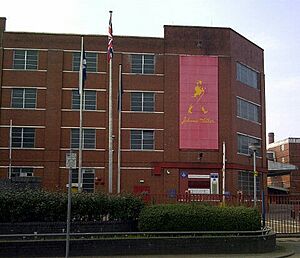
Kilmarnock is also home to The HALO Urban Regeneration. This project focuses on digital learning and helping new businesses grow. It is expected to bring a lot of money to Scotland's economy. Scotia, a window and door company, also has its main office and factory in Kilmarnock.
The famous Scotch whisky brand Johnnie Walker started in Kilmarnock in 1820. It was created by John 'Johnnie' Walker. The whisky was made and bottled in the town for many years. A large bottling plant opened in 1956. It was the biggest in the world at the time.
In 2009, the company that owns Johnnie Walker, Diageo, decided to close the plant. This caused a lot of upset. Production stopped in Kilmarnock in 2012 after 192 years. The old plant site is now home to Ayrshire College and The HALO Urban Regeneration.
Kilmarnock's traditional industries included textiles and heavy engineering. Companies like Andrew Barclay Sons & Co. made locomotives (trains) from 1837. Glenfield and Kennedy made valves. Glenfield Valves still operates in Kilmarnock. Andrew Barclay Sons & Co. is now Brodie Engineering.
Blackwood and Morton of Kilmarnock (BMK) made carpets. Their carpets were known worldwide for their quality. The company closed in 2005. Shoe making was also a big industry. Both Clarks and Saxone Shoes had factories here. The Saxone Shoe factory was the largest in Scotland.
Coal was mined near Kilmarnock. Quarrying (digging for stone) also took place. Clay was used to make bricks, tiles, and sanitary items. These products were sent all over the world from Kilmarnock.
Kilmarnock had one of the first tram railways in the world. It ran to Troon. The Glasgow & South Western Railway built trains here. They made almost 400 locomotives. Train repairs stopped in 1952, and the works closed in 1959. However, Brodie Engineering still makes and maintains trains in the town.
Getting Around Kilmarnock
Before the 1700s, roads in Kilmarnock were rough and hard to use. In 1767, a law was passed to improve them. New and better roads were built, connecting Kilmarnock to nearby towns like Ayr and Irvine. These better roads helped trade and business grow.
In 1812, the Kilmarnock and Troon Railway opened. It was Scotland's first railway. It mainly carried coal, but also had passenger services. In 1904, Kilmarnock built its own electric tramway system.
Today, Kilmarnock railway station connects the town to major places in Scotland. You can travel to Stranraer for ferries to Northern Ireland. You can also go as far as Carlisle and Newcastle in England.
Kilmarnock's first custom-built bus station opened in 1923. It was one of the first in Scotland. The current bus station has been updated recently. The town is connected to Glasgow by the M77 motorway. Stagecoach Group runs most of the bus services in the town. Kilmarnock is on three main roads: the A71, the A76, and the A77/M77.
Kilmarnock does not have an international airport. However, Glasgow Prestwick Airport is only about 14 miles away.
Learning in Kilmarnock
Kilmarnock has ten primary schools, three secondary schools, and thirteen nursery schools. These schools are managed by East Ayrshire Council. For further education, students can attend Ayrshire College.
The oldest secondary school is Kilmarnock Academy. It dates back to the 1600s. This school is special because two of its former students won Nobel Prizes. One was Sir Alexander Fleming, who discovered Penicillin. The other was The 1st Baron Boyd-Orr, known for his work on nutrition.
Grange Academy is one of only seven Scottish Football Association (SFA) Performance Schools in Scotland. This means it helps young footballers develop their skills.
Loanhead Primary School opened in 1905. It was built to teach primary students in the east of Kilmarnock. Andrew Carnegie laid its foundation stone. The building is now a listed building, meaning it's historically important.
Over the years, as Kilmarnock grew, many new primary schools opened. These include Shortlees Primary School (1951) and Whattriggs Primary School (2019).
Early Childhood Centres
- Cairns Early Childhood Centre
- Dean Park Nursery
- Flowerbank Early Childhood Centre
- Gaelic Early Childhood Centre
- Gargieston Early Childhood Centre
- Hillbank Early Childhood Centre
- James Hamilton Early Childhood Centre
- Onthank Early Childhood Centre
- Riccarton Early Childhood Centre
- Shortlees Early Childhood Centre
- St Andrew's Early Childhood Centre
- Whatriggs Early Childhood Centre
- Loanhead Early Childhood Centre
Primary Schools
- Annanhill Primary School
- Gargieston Primary School
- Hillhead Primary School
- Loanhead Primary School
- James Hamilton Primary School
- Mount Carmel Primary School
- Onthank Primary School
- Shortlees Primary School
- St Andrew's Primary School
- Whattriggs Primary School
Secondary Schools
- Kilmarnock Academy
- Grange Academy
- Saint Josephs' Academy
Special Schools
- Park School
- Willowbank School
Further Education
- Ayrshire College (Kilmarnock Campus)
Kilmarnock's Culture and Fun
Kilmarnock has many historic buildings. The Dick Institute, which opened in 1901, is a museum and library. It has art galleries and displays about local history and nature.
The first collection of poems by Robert Burns, Poems, Chiefly in the Scottish Dialect, was published in Kilmarnock on July 31, 1786. This book is famous as the Kilmarnock Edition. A statue of Robert Burns and his publisher, John Wilson, stands in the town centre.
The Burns Monument in Kay Park opened in 1879. It used to have a museum. After a fire in 2004, it was rebuilt and reopened as the Burns Monument Centre.
Dean Castle in Kilmarnock has a collection of old armour and weapons. It also has musical instruments.

The Scottish band The Proclaimers wrote a song called "The Joyful Kilmarnock Blues". The famous song "The Ballroom Blitz" by The Sweet was inspired by an event at Kilmarnock's Grand Hall in 1973. The band was performing when bottles were thrown from the crowd!
Sports in Kilmarnock
Kilmarnock is home to Kilmarnock F.C., a professional football club. It is the oldest professional football club in Scotland. The club was one of the first members of the Scottish Football Association in 1873. Their first game in the Scottish Cup was in 1873.
The town has two golf courses: Annanhill Golf Course and Caprington Golf Course. The Caprington course has both an 18-hole and a 9-hole course.
The Galleon Centre is a local leisure complex. It has a swimming pool, ice rink, squash courts, gym, and a bowling green. The Ayrshire Athletics Centre has a 400m running track. It was used as a training ground for athletes during the 2014 Commonwealth Games.
Grange Academy, one of the town's secondary schools, is a special SFA Performance School. This means it helps talented young footballers.
Twin Towns
Kilmarnock is twinned with several cities in other countries. This means they have special friendly links.
- Alès, France
- Herstal, Belgium
- Joué-lès-Tours, France
- Kulmbach, Germany
- Santa Coloma de Gramenet, Spain
Famous People from Kilmarnock
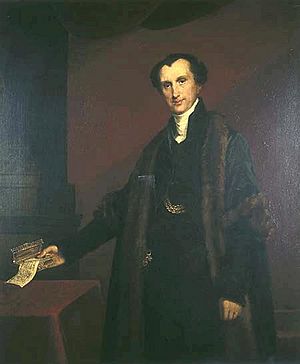
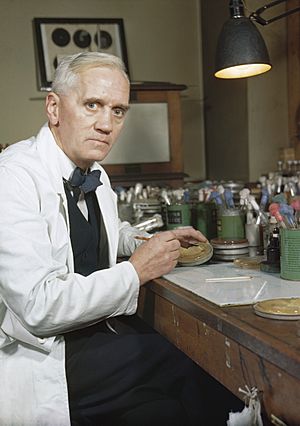
Many notable people have been born, lived, or had connections to Kilmarnock.
- Literature and Arts
- Gilbert Adair; writer
- Steven Brown; artist known for his McCoo artwork
- Steven Cree, actor, known for Outlander
- Fatherson, a rock band formed in the town
- James Buckley, actor from The Inbetweeners, lived here
- Ben and James Johnston, members of the band Biffy Clyro
- Kirsty McCabe; weather presenter
- William McIlvanney; writer, known for his Laidlaw books
- Colin Mochrie; comedian
- Kirsty Wark; TV news journalist
- Medicine and Science
- John Boyd Orr; biologist and Nobel Peace Prize-winner
- Alexander Fleming; discoverer of penicillin and Nobel Prize-winner, attended Kilmarnock Academy
- Business
- Sir Alexander Walker; creator of Johnnie Walker whisky
- John "Johnnie" Walker; started Johnnie Walker whisky
- Marie Macklin, CEO of The KLIN Group and founder of The HALO Urban Regeneration
- Politics
- James Shaw; Lord Mayor of London in 1805
- Sports
- Joanne Calderwood; mixed martial artist
- Margaret McDowall; silver medal winner in swimming at the 1952 Helsinki Olympics
- Billy Gilmour, footballer for Napoli and the Scotland national football team, attended Grange Academy
- Other Notable People
- Charles Ewart; cavalryman who captured a French flag at the Battle of Waterloo
- Jim McColl, TV presenter and horticulturalist
See also
 In Spanish: Kilmarnock para niños
In Spanish: Kilmarnock para niños


